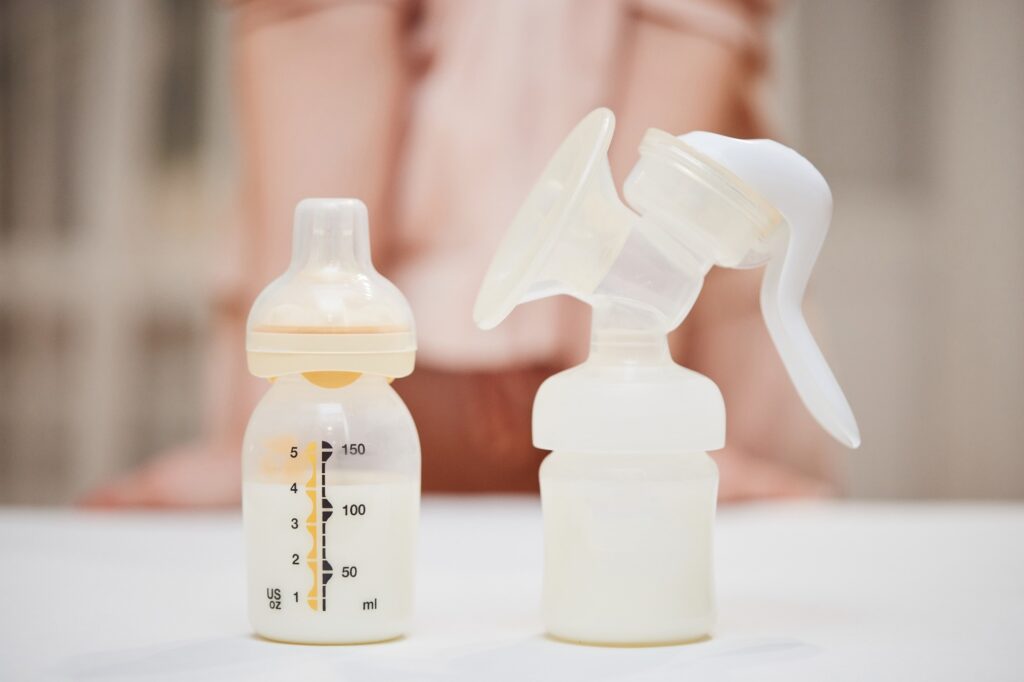In a recent study in the journal Nutrients, scientists looked into human milk banking (HMB) practices and the health outcomes of infants who received donated breast milk.
 Study: Personalized nutrition for early gut microbiome development through human milk banking: the pursuit of the perfect match. Image credit: Evgenyrychko/Shutterstock.com
Study: Personalized nutrition for early gut microbiome development through human milk banking: the pursuit of the perfect match. Image credit: Evgenyrychko/Shutterstock.com
Early microbiome establishment and human health
Millions of microorganisms inhabit the intestines of humans and animals and influence the physiological, immune and metabolic functions of the host. Several studies have pointed out the importance of early microbial colonization, a process that has profound effects on an individual's health throughout their lifespan.
Babies born vaginally are exposed to their mother's vaginal and fecal microbiota, which is mainly composed of Prevotella, E. coli/Shigella, Lactobacillus, Bacteroides, Atopobium and Bifidobacteria. In contrast, babies born by Caesarean section are exposed to their mother's skin and hospital environment microbiota. This is due to higher concentrations of Staphylococcus, Klebsiella and E. coli, and lower concentrations of Bacteroides and Bifidobacteria, which subsequently colonize the gut microbiota.
Breastfeeding is the most important factor for optimal colonization and establishment of the infant's gut microbiota. Oligosaccharides are a major component of breast milk and support the growth of beneficial bacteria such as Lactobacillus, Bifidobacteria and Bacteroides. The feeding method is also important for early microbiota colonization, as beneficial bacteria such as Lactobacillus and Bifidobacteria present on the mother's nipples are also transferred during breastfeeding.
In cases of premature birth or early medical conditions, breastfeeding may not be possible. These babies are often fed infant formula, but official international nutrition and health guidelines recommend the use of donated human milk (DHM) from human milk banks.
Several studies have shown that DHM is not a perfect match for mother's breast milk in terms of infant growth and development. In fact, it has been observed that infants fed DHM and autologous milk (OMM) have different gut microbiota composition, which may be due to milk processing, including pasteurization, in milk banks.
 Comparison of the main nutritional and bioactive components of different sources of infant nutrition, including the mother's own breast milk, pasteurized donor breast milk, and commercial infant formula.
Comparison of the main nutritional and bioactive components of different sources of infant nutrition, including the mother's own breast milk, pasteurized donor breast milk, and commercial infant formula.
Hospital initiatives regarding human milk donation, safety and quality
Any healthy woman living a healthy lifestyle can become a breast milk donor. The European Milk Banking Association (EMBA) recommends that the process of breast milk donation should include serological testing of donors, conducting a verbal interview, obtaining prior consent for the use of their breast milk, training donors on hygiene issues, and providing appropriate ongoing support.
EMBA exclusion criteria included smokers, recreational drug users, people with human immunodeficiency virus (HIV) infection, syphilis or human T-lymphotropic virus, hepatitis B or C, drug users not on the EMBA-approved drug list, people with tattoos or piercings, and people following a vegan diet without taking vitamin B12 supplements.
Milk derived from HMB must be pasteurized. Pasteurization inactivates bacterial and viral pathogens and preserves the beneficial nutrients in human milk, including fatty acids, lactose and most minerals. However, heat processing can also reduce bioactive compounds such as immune cells, hormones, cytokines, immunoglobulins and water-soluble vitamins.
Several proteins and enzymes, including lipase, amylase, lactoferrin, and amylase, are reduced in activity by heating. Notably, human milk oligosaccharides (HMOs) are resistant to pasteurization and remain in donated breast milk. Additionally, HMB is standard fortification based on the micronutrient content of milk.
Because heat treatment alters the composition of human milk, a number of alternative techniques are also used, including high temperature short time pasteurization (HTST), ultraviolet radiation (UV-C), high pressure processing (HPP) and thermosonication. HPP methods cause less damage to exosomes and their microribonucleic acid (miRNA) content, while UV-C treatment better preserves important bioactive components of fresh human milk.
The EMBA considers that Holder Pasteurization (HoP) is the safest method of processing DHM, despite the removal of beneficial bacteria from milk, and therefore technical improvements are needed to minimize the deterioration of beneficial components.
Health status of breastfed and formula-fed infants
Breastfed infants have higher levels of beneficial gut bacteria, such as Bifidobacteria, than formula-fed infants. In fact, the gut microbial profile of full-term breastfed infants is significantly different from that of infants fed cow's milk formula.
For example, gut microbiota profiles of breastfed infants have been observed to have lower levels of Clostridium and higher levels of Veillonella, Bifidobacteria, and Propionibacterium. These microorganisms produce anti-inflammatory short-chain fatty acids (SCFAs).
Several studies have shown that breastfeeding during early childhood optimally shapes the development of the infant's gut microbiota. Breast milk reduces the risk of necrotizing enterocolitis (NEC), a gastrointestinal disease that commonly occurs in premature infants and is associated with delayed maturation of the gut microbiota. Studies have also shown that immunoglobulin A (IgA) in breast milk plays an important role in preventing NEC in both term and preterm infants.
Formula feeding can lead to rapid weight gain during childhood, whereas breastfeeding can prevent childhood obesity. Breastfeeding reduces the risk of developing atopic diseases such as asthma during the first 3-6 months of an infant's life. Breastfeeding also improves neurocognitive development in preterm infants.
Conclusion
Although donor milk is not perfectly identical to OMM, especially in terms of microbial composition, DHM is the best alternative when breast milk is unavailable. However, further studies are needed to assess the short- and long-term health effects of DHM on premature infants.
Journal References:
Hick, E., Suárez, M., Rey, A., et al. (2024) Personalized nutrition from human milk banks for early gut microbiota development: the pursuit of the perfect match. Nutrients 16(13); 1976. doi:10.3390/nu16131976
Source link



